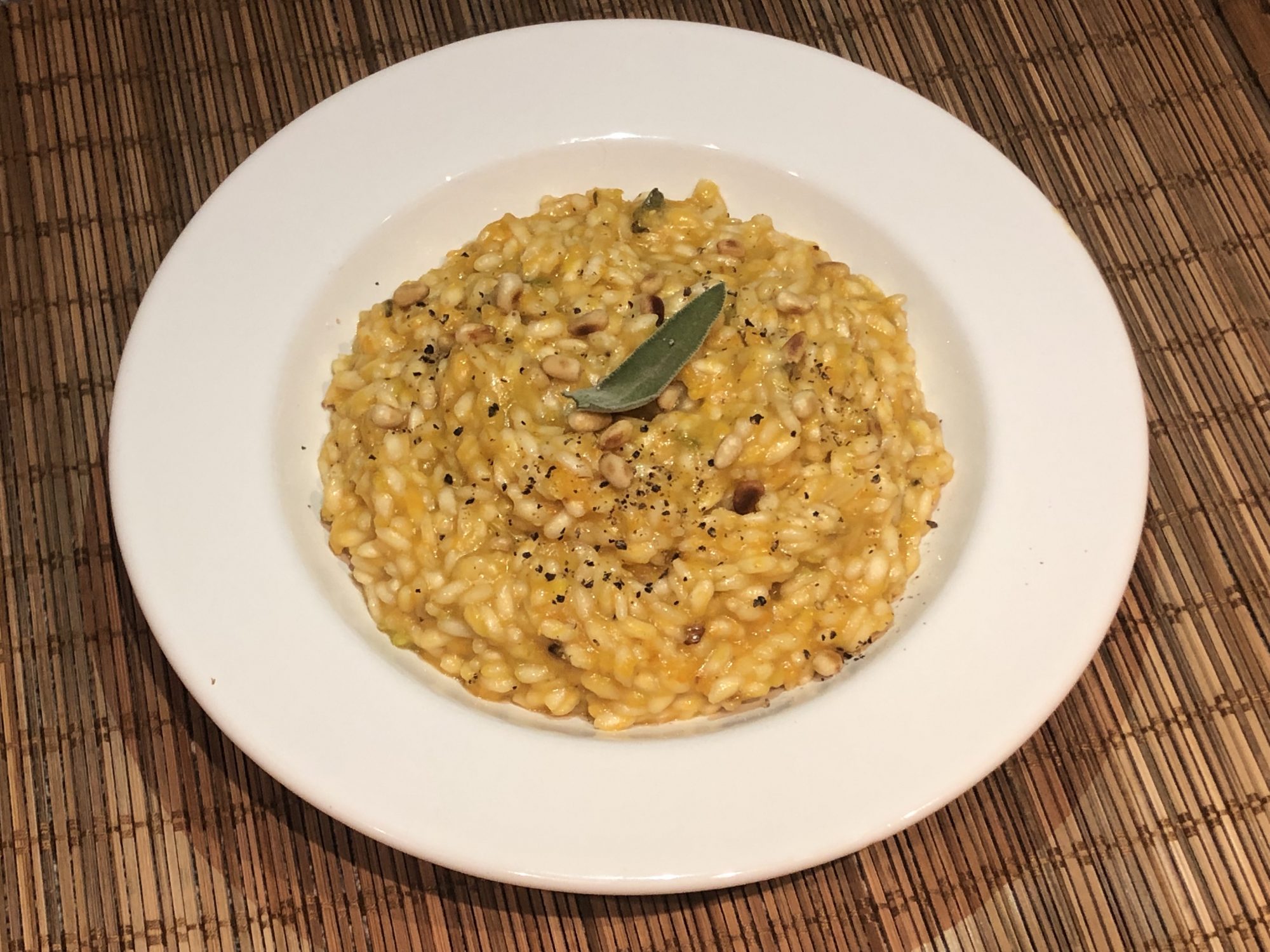Laure's Squash and Sage Risotto
(Risotto à la courge musquée de Laure)

Ingredients
Directions
Preheat oven to 180 degrees celsius. Mix 3 tbsps olive oil with half the garlic (1 clove) and 6 chopped sage leaves. Arrange the Squash segments onto a baking tray and rub in the mixture to each segment so each is perfectly coated. Season with salt and pepper and roast for 40 minutes.
Warm a good glug of olive oil in a pan over medium-low heat (better to add too much than too little as there is no butter in this recipe), and add 4 finely chopped sage leaves. It important not to heat the pan too much as to burn the leaves - but warm enough that the sage releases the lovely earthy oils and flavours the oil. Stir occasionally for 3 minutes.
Increase the heat to medium and add the leek and shallots to the pan. Fry for 5 - 10 minutes, until they have softened and start to turn translucent. Add the remaining garlic, chilli and thyme and fry for a further 2 minutes until fragrant. Season with sea salt and freshly ground black pepper.
Add the Arborio rice to the pan, stirring constantly to coat each grain. Continue for a minute so you can hear the rice making a quiet crackling noise. Stirring is essential as to not burn the rice.
Add 150ml white wine, stirring to fully incorporate. After all the wine has been absorbed, add 1 ladle at a time of vegetable stock, waiting until the previous ladle has fully been absorbed. This is the most crucial part of any risotto recipe and you should take your time, stirring constantly. When you are halfway through the stock, add the remaining wine and sage, then continue with the stock, 1 ladle at a time. Turn the heat down so it is simmering gently. After 15 - 20 minutes the rice should appear creamy and have a slight bite to it. Turn the heat off, but put a lid on the pan to retain the heat and moisture inside.
Remove the squash from the oven, and scoop the flesh and cooking juices to a bowl (discarding the skin). Mash with a fork until it is homogenous but slightly stringy. Add the mash and vegetarian parmesan (if using) to the risotto and stir through. If no hard cheese is used then taste and add salt until you are happy with it. Add extra stock if it is too thick but do so sparingly.
Toast the pine nuts in a dry frying pan on medium heat, tossing until golden. Spoon the risotto into bowls and garnish with pine nuts. Serve immediately.
Servings 4
- Amount Per Serving
- Calories 651
- % Daily Value *
- Total Fat 28.1g44%
- Saturated Fat 3.1g16%
- Cholesterol 0mg
- Sodium 22mg1%
- Potassium 1041mg30%
- Total Carbohydrate 90.1g31%
- Dietary Fiber 11g44%
- Sugars 6.9g
- Protein 10.1g21%
- Calcium 5%
- Iron 63%
Percent Daily Values are based on a 2,000 calorie diet. Your daily value may be higher or lower depending on your calorie needs.
Ingredients
Directions
Preheat oven to 180 degrees celsius. Mix 3 tbsps olive oil with half the garlic (1 clove) and 6 chopped sage leaves. Arrange the Squash segments onto a baking tray and rub in the mixture to each segment so each is perfectly coated. Season with salt and pepper and roast for 40 minutes.
Warm a good glug of olive oil in a pan over medium-low heat (better to add too much than too little as there is no butter in this recipe), and add 4 finely chopped sage leaves. It important not to heat the pan too much as to burn the leaves - but warm enough that the sage releases the lovely earthy oils and flavours the oil. Stir occasionally for 3 minutes.
Increase the heat to medium and add the leek and shallots to the pan. Fry for 5 - 10 minutes, until they have softened and start to turn translucent. Add the remaining garlic, chilli and thyme and fry for a further 2 minutes until fragrant. Season with sea salt and freshly ground black pepper.
Add the Arborio rice to the pan, stirring constantly to coat each grain. Continue for a minute so you can hear the rice making a quiet crackling noise. Stirring is essential as to not burn the rice.
Add 150ml white wine, stirring to fully incorporate. After all the wine has been absorbed, add 1 ladle at a time of vegetable stock, waiting until the previous ladle has fully been absorbed. This is the most crucial part of any risotto recipe and you should take your time, stirring constantly. When you are halfway through the stock, add the remaining wine and sage, then continue with the stock, 1 ladle at a time. Turn the heat down so it is simmering gently. After 15 - 20 minutes the rice should appear creamy and have a slight bite to it. Turn the heat off, but put a lid on the pan to retain the heat and moisture inside.
Remove the squash from the oven, and scoop the flesh and cooking juices to a bowl (discarding the skin). Mash with a fork until it is homogenous but slightly stringy. Add the mash and vegetarian parmesan (if using) to the risotto and stir through. If no hard cheese is used then taste and add salt until you are happy with it. Add extra stock if it is too thick but do so sparingly.
Toast the pine nuts in a dry frying pan on medium heat, tossing until golden. Spoon the risotto into bowls and garnish with pine nuts. Serve immediately.
